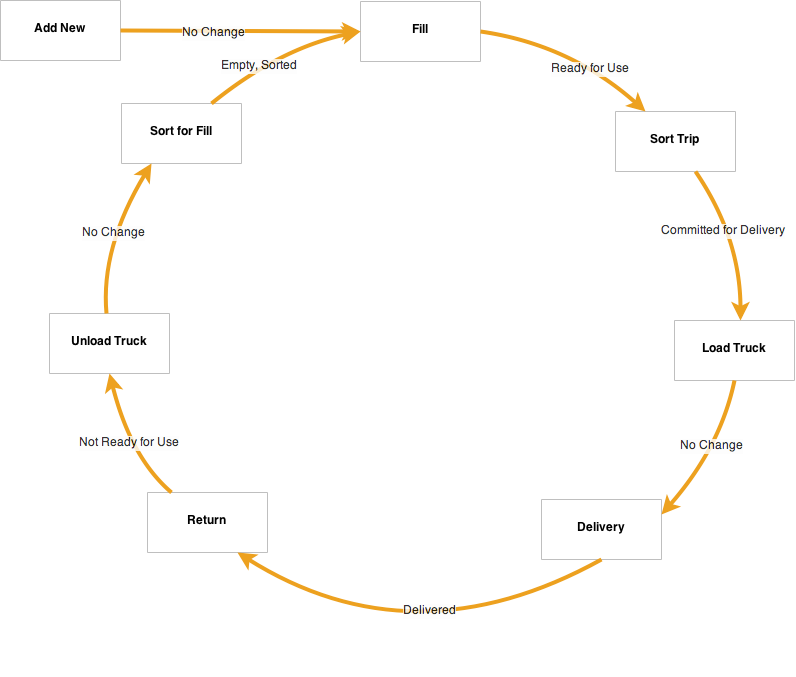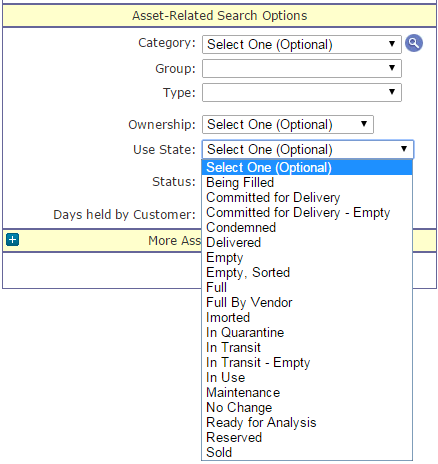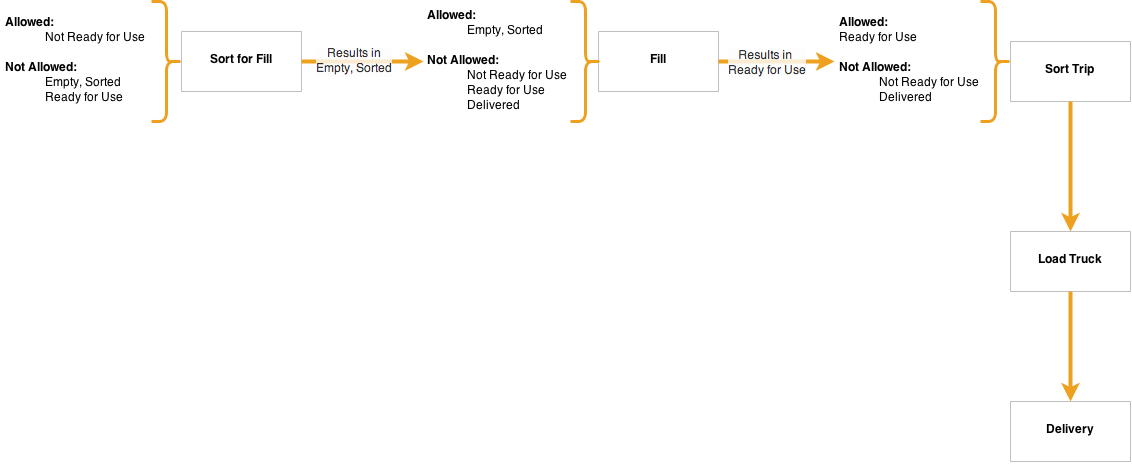Use States
A Use State describes the status or condition of an asset. Sometimes called a Status, a Use State is assigned to every active, barcoded asset in TrackAbout, based on the last action that happened to that asset. For example, assets that were delivered to a customer would have a use state of "Delivered", while assets that had just been filled or cleaned would have a use state of "Ready for Use".
Available Use States
The Use State of an asset is shown in the Status section of the Asset Details
Use State shown as Status in TrackAbout Mobile 6 (left) and TrackAbout Mobile iOS (right)
TrackAbout supports more than 15 different Use States. A list of these is found below. Each Use State can be renamed to suit your asset flow. Please contact TrackAbout Support for details.
|
Default Use State Name |
Examples of a Customized Name |
|---|---|
|
|
|
|
|
Empty or Dirty |
|
|
Full or Clean |
|
|
|
|
|
|
|
|
|
|
|
|
|
|
|
|
|
|
|
|
|
|
|
|
|
|
|
|
|
|
|
|
|
|
|
|
|
|
|
|
|
|
|
|
|
|
|
|
|
|
|
|
|
|
|
|
|
|
|
|
How Assets Change Use States

In the example above, you can see that each action results in a Use State that stays on the asset until the next action occurs. Filled goes to Ready for Use, Load Truck goes to Committed for Delivery and so on. Add New and Unload Truck are different because they each set a Use State of "No Change" on the assets.
Every action in TrackAbout changes some aspect about the assets scanned in the action. Some of these actions change the state of the asset, but other actions change other aspects of the asset but not its condition. For example, a Locate action changes the location of the asset, but it will not change the state of the asset, because simply moving the asset from one location to another does not change its state. In cases like this, the actions actually set a Use State of No Change, and whenever you view the asset, you will see the last Use State that was set on the asset. So if you unload an asset from a truck that is no longer ready for use, the Use State on the asset will still be Not Ready for Use. In the tables below, you can see the actions that typically change the Use State on an asset, and which do not.
Actions that Typically Set a Use State
|
Action |
Use State |
|---|---|
Add New Bulk Tank |
Delivered |
Analysis
|
Ready for Use |
Condemn Assets
|
Condemned |
Delivery
|
Delivered |
Fill
|
Ready for Use or Ready for Analysis |
Locate Empty
|
Not Ready for Use |
Locate Full
|
Ready for Use |
Maintenance In House
|
The Use State is determined by the maintenance action completed |
Receive From Vendor
|
Ready for Use |
Sell Assets
|
Sold |
Sort Assets
|
Empty, Sorted |
|
|
Committed for Delivery |
Actions that Typically do not Set a Use State
|
Action |
|---|
|
|
|
|
|
|
|
|
|
|
|
|
|
|
|
|
|
|
|
|
|
|
|
|
|
|
|
|
Setting Use State Based on Location or Customer
In some cases, the location of the asset should determine what the use state of the asset is. For example, if an asset is at a certain location for maintenance, any asset that is set to that location should have its use state set to Maintenance. This can be accomplished through the Location/Customer-based Default Use States feature. With this enabled, each location or customer can be configured to set the default use state for assets that are set to that location or customer.
Setting the use state based on location or customer is limited to those actions that do not typically set a use state (see table above). If an action is performed that normally does set a use state on the asset, the resulting use state of the action will override the default use state of the location or customer. For example, if a location is set to have a default use state of Empty, if a Fill is performed at that location, the use state of the assets in the fill will be set to Full or Ready for Use instead of empty.
To enable Location/Customer-based Default Use States for locations or customers, contact TrackAbout Support.
Use State Fall Backs
For some client business processes, having just one resulting Use State for an Action is insufficient. TrackAbout provides Use State Fallbacks which allow us to revert an asset's Use State back to a previous Use State that is appropriate for the asset.
For instance, consider a client who uses Branch Transfers. They load full and empty assets onto a Truck, setting the use state to be In Transit. When they are transferred to the recipient branch and unloaded, the Unload Truck action doesn't change an assets' Use State at all.
This means that all of our assets that were Loaded and Transferred, will still be in a Use State of "In Transit" when they come off the truck. However, the recipient branch will need to be able to use them! We need the assets' Use States to reflect whatever they were BEFORE the Load Truck (likely something like Full, Empty or Maintenance). Therefore, the Use State Fallback is used to revert the Use State back to what it was BEFORE the Load Truck.
Why use Use States?
Used with the reports available in TrackAbout, use states provide another level of insight into your asset inventory by showing how many assets are in each step of the asset life cycle. In some TrackAbout modules, use states are also used to force assets to go through a specific process by allowing only assets with certain use states to be valid for certain actions.
Use States for Reporting
The Asset Search page allows you to search for assets by any criteria associated with the asset. This includes the Use State of the asset. So you could search for assets that have a Use State of Empty and see the details of the assets.

The Current Inventory page allows you to filter your inventory search by Use State. In this case, you could see all the Ready for Use assets in a particular location and how long they have been there.

Use State Validation
Use States can also be used to ensure that an asset follows a certain flow as it moves throughout the plant and back out to the customer. This is done by only allowing assets of certain Use States to be valid for particular actions.

Notice that each action has a list of Use States that are allowed, and a list that are not. The asset's Use State is validated when it is scanned in the action. If the asset is in a valid Use State, it will be added to the action; if not, a warning will be given.
This feature, along with other business rules are available in the Palletization module.
